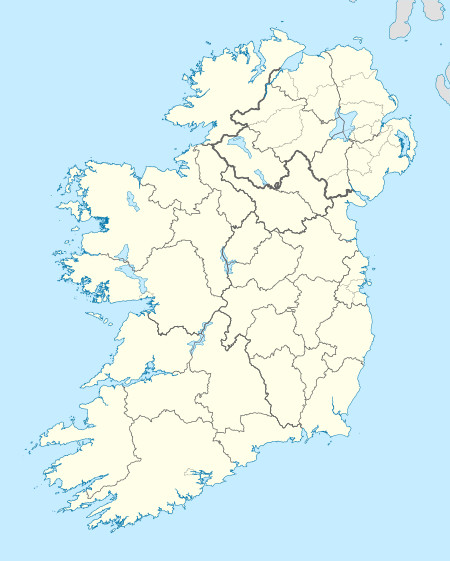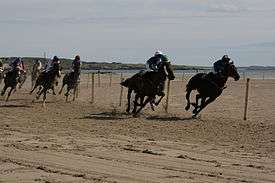Omey Island
| Native name: <span class="nickname" ">Iomaidh | |
|---|---|
 Omey Island | |
| Geography | |
| Location | Atlantic Ocean |
| Coordinates | 53°32′07″N 10°09′27″W / 53.53528°N 10.15750°WCoordinates: 53°32′07″N 10°09′27″W / 53.53528°N 10.15750°W |
| Administration | |
| Province | Connacht |
| County | Galway |
| Demographics | |
| Population | 1 (2011) |
| Additional information | |
| tidal island | |
Omey Island (Irish: Iomaidh) is a tidal island situated near Claddaghduff on the western edge of Connemara in County Galway, Ireland. From the mainland the island is inconspicuous and almost hidden. It is possible to drive or walk across a large sandy strand to the island by following the arrowed signs. At high tide, the water is deep enough to cover a car.
History
Monastic heritage

In the early-to-mid-1990s a team of archaeologists from University College Dublin began work to study the monastic heritage of the island, long known for being the site of a monastery and settlement reportedly founded by the prodigious St Feichin. In fact, its name derives from the Irish Iomaidh Feichín meaning Feichín's bed or seat.
The excavation gave new insights into the life of early Christianity in Ireland and included one of the few known burials of a woman within a monastic burial ground. The site is believed to date from the early 6th century.
The island of Omey remains a place of devotion to Saint Feichín to this day, with a Holy Well situated by the western edge and several other key landmarks of piety. This includes a later medieval parish church - with the majority of its vast stones still very much in place (having been buried in centuries of sand until the parish priest took matters into his own hands and, with the help of locals, dug up the area surrounding it).
St Feichín is reported to have established many such communities across the west of Ireland and is considered one of the most important of the early founders of the rich tradition of Irish Christianity.
Late Medieval and Modern times
The O'Tooles of Leinster settled here in the early 1500s, under the protection of the O'Flahertys. During the Cromwellian settlements the Browns and D'Arcys took over. In the early 1800s two townlands on Omey belonged to the Martins of Ballynahinch and one to the D'Arcys of Clifden.[1]
John MacNeice, a Church of Ireland bishop famous for his opposition to the Ulster Covenant[2] was born and raised on Omey.
Places of interest
In several places shell middens can be found on the island. Some of those have been carbon-dated to AD 1000–1500.[1] The ruin of Teampaill Feichin, the medieval parish church, excavated from the sand in 1981, stands on the site of the abbey said to have been founded by Saint Feichín. Nearby is a Holy Well with a small shrine around it.[1]
Inhabitants and visitors

The population of the island has diminished drastically from its maximum when hundreds of people lived there in the early 19th century.[3] The National School (opened in 1883) closed in 1973. In 1988 there were just three households left. [1] In fact, for over ten years the only full-time inhabitant was the former stuntman and wrestler Pascal Whelan. The Irish poet Richard Murphy lived for some time on Omey Island, where he built an octagonal retreat that still exists.[1] In 2003, the Irish Artist Sean Corcoran witnessed a strange creature in the lake that he describes as being similar to a Dobhar-chu (Master Otter).[4][5] There is a graveyard on the island that is still in use today (Ula Bhreandain).[6]
The beach is the site of the annual Omey Races, reestablished in 2001. This horse racing event is held in late summer (July/August).[7]
Demographics
The table below reports data on Omey Island's population taken from Discover the Islands of Ireland (Alex Ritsema, Collins Press, 1999) and the Census of Ireland.
| Historical population | |||||||||||||||||||||||||||||||||||||||||||||||||||||||||||||||||||||||||||||||||||
|---|---|---|---|---|---|---|---|---|---|---|---|---|---|---|---|---|---|---|---|---|---|---|---|---|---|---|---|---|---|---|---|---|---|---|---|---|---|---|---|---|---|---|---|---|---|---|---|---|---|---|---|---|---|---|---|---|---|---|---|---|---|---|---|---|---|---|---|---|---|---|---|---|---|---|---|---|---|---|---|---|---|---|---|
|
|
| |||||||||||||||||||||||||||||||||||||||||||||||||||||||||||||||||||||||||||||||||
| Source: Central Statistics Office. "CNA17: Population by Off Shore Island, Sex and Year". CSO.ie. Retrieved October 12, 2016. | |||||||||||||||||||||||||||||||||||||||||||||||||||||||||||||||||||||||||||||||||||
The sole inhabitant runs the pub on the island
See also
References
- 1 2 3 4 5 Robinson, Tim (2005). Connemara, Part 1: Introduction and Gazetteer. Folding Landscapes, Roundstone, Ireland. pp. 53–54. ISBN 0-9504002-5-4.
- ↑ Hayes, Maurice (15 April 2012). "Well-written study of brave and decent bishop MacNeice". Irish Independent. Retrieved 2013-01-29.
- ↑ Irish Islands Website Created by John Chambers, Saint Cronans School, Bray.
- ↑ Supposedly Mythical Creature Written by Dr Karl Shuker
- ↑ Irish Times Article Written by Lorna Siggins, October 12, 2009
- ↑ Phelan, Paul (2011). Connemara and Mayo, Mountain, Coastal and Island Walks. The Collins Press. pp. 8–10. ISBN 9781848891029.
- ↑ Omey Races website
External links
- Hoffstot, Darlyn Brewer (1 August 1999). "Where Legends Outnumber People". The New York Times. Retrieved 2013-01-29.
| Wikimedia Commons has media related to Omey Island. |
| Wikivoyage has a travel guide for Omey Island. |